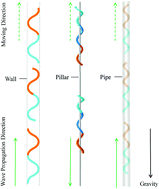Architectures of soft robotic locomotion enabled by simple mechanical principles†
Abstract
In nature, a variety of limbless locomotion patterns flourish, from the small or basic life forms (Escherichia coli, amoebae, etc.) to the large or intelligent creatures (e.g., slugs, starfishes, earthworms, octopuses, jellyfishes, and snakes). Many bioinspired soft robots based on locomotion have been developed in the past few decades. In this work, based on the kinematics and dynamics of two representative locomotion modes (i.e., worm-like crawling and snake-like slithering), we propose a broad set of innovative designs for soft mobile robots through simple mechanical principles. Inspired by and going beyond the existing biological systems, these designs include 1-D (dimensional), 2-D, and 3-D robotic locomotion patterns enabled by the simple actuation of continuous beams. We report herein over 20 locomotion modes achieving various locomotion functions, including crawling, rising, running, creeping, squirming, slithering, swimming, jumping, turning, turning over, helix rolling, wheeling, etc. Some are able to reach high speed, high efficiency, and overcome obstacles. All these locomotion strategies and functions can be integrated into a simple beam model. The proposed simple and robust models are adaptive for severe and complex environments. These elegant designs for diverse robotic locomotion patterns are expected to underpin future deployments of soft robots and to inspire a series of advanced designs.



 Please wait while we load your content...
Please wait while we load your content...